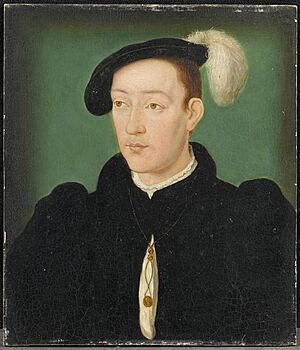Francis III, Duke of Brittany facts for kids
Quick facts for kids Francis III |
|
|---|---|
| Dauphin of France | |

Portrait by Corneille de Lyon
|
|
| Duke of Brittany | |
| Reign | 20 July 1524 – 10 August 1536 |
| Predecessor | Claude |
| Successor | Henry II |
| Born | 28 February 1518 Château d'Amboise |
| Died | 10 August 1536 (aged 18) Château de Tournon |
| Burial | Saint Denis Basilica |
| House | Valois-Angoulême |
| Father | Francis I of France |
| Mother | Claude, Duchess of Brittany |
| Religion | Roman Catholicism |
Francis III (born February 28, 1518 – died August 10, 1536) was a French prince. He was known as the Dauphin of France. This title meant he was the heir to the French throne. After 1524, he also became the Duke of Brittany.
Francis and his younger brother, Henry, faced a tough time. They were held as hostages in Spain for three years. This happened because their father, King Francis I of France, was captured in a battle. Francis later became the Duke of Brittany in 1532. This event helped bring Brittany closer to the Kingdom of France. Francis died when he was only 18 years old.
Life of a Young Prince
Francis was the first son of King Francis I of France. His mother was Duchess Claude of Brittany. When Francis was born, his father was very proud. He called him "a beautiful dauphin." He said Francis was "the most beautiful and strong child." His mother also thought he was wonderful.
Francis was christened, or baptized, in Amboise. This happened on April 25, 1519. The famous artist Leonardo da Vinci helped design the decorations for the event. Leonardo had been brought to Amboise by King Francis I.
Hostage in Spain
One of the most talked-about parts of Francis's short life was his time as a hostage. He and his brother Henry were sent to Spain. Their father, King Francis I, had been defeated in the Battle of Pavia (1525). He was captured by Emperor Charles V. To get the king released, a deal was made. It was called the Treaty of Madrid (1526).
As part of the deal, Francis and Henry had to take their father's place. So, on March 15, 1526, the exchange happened. The king was set free, but his two young sons became prisoners. Francis was eight years old at the time. He and Henry spent the next three years as captives of Charles V. This difficult experience left a lasting mark on both brothers.
During his time in Spain, Francis was quite quiet. He seemed to accept being a prisoner. He became a bit withdrawn and preferred to wear black clothes. People noticed he seemed more thoughtful, almost like a Spaniard.
Duchy of Brittany
In 1524, Francis inherited the Duchy of Brittany. This happened after his mother, Duchess Claude, passed away. A duchy is a territory ruled by a duke or duchess. Even though Francis was the Duke, French officials actually managed Brittany.
In 1532, there were many discussions with leaders from Brittany. They made demands to the French king. They wanted Francis to arrive in Rennes as the Duke and owner of Brittany. King Francis I would manage the duchy. After Brittany joined France, Francis would promise to respect Brittany's rights.
Francis agreed to these demands. He signed an order that officially joined the Duchy of Brittany with France. On August 14, 1532, Francis was crowned Duke Francis III. This ceremony took place in Rennes Cathedral. Later, when Henry became King of France, Brittany and the French crown became even more closely linked.
The Dauphin's Death
Dauphin Francis died at the Château de Tournon. He passed away on August 10, 1536. He was only 18 years old. Many people thought his death was suspicious. Some believed he had been poisoned. However, there is also evidence that he died from natural causes. It's possible he had a disease called tuberculosis.
Before he died, Francis had been playing a game of tennis. After the game, he asked for a cup of water. His secretary, Count Montecuccoli, brought it to him. After drinking, Francis became very ill. He died a few days later.
Count Montecuccoli was accused of poisoning the Dauphin. Some thought he was working for Emperor Charles V. When his room was searched, a book about different types of poisons was found. Under questioning, Montecuccoli confessed to poisoning Francis. He was then executed.
In those days, before modern science, people often suspected poison. This was especially true if a young, healthy person died suddenly after eating or drinking. It was hard to find proof of poison back then. So, it was often thought to be a quick and untraceable way to commit murder. There have been other cases in French history where people suspected poison was used in the royal family.
|
Francis III, Duke of Brittany
Cadet branch of the Capetian dynasty
Born: 28 February 1518 Died: 10 August 1536 |
||
| Regnal titles | ||
|---|---|---|
| Preceded by Claude |
Duke of Brittany 20 July 1524 – 10 August 1536 |
Succeeded by Henry |
| French royalty | ||
| Vacant
Title last held by
Francis |
Dauphin of France 28 February 1518 – 10 August 1536 |
Succeeded by Henry |

